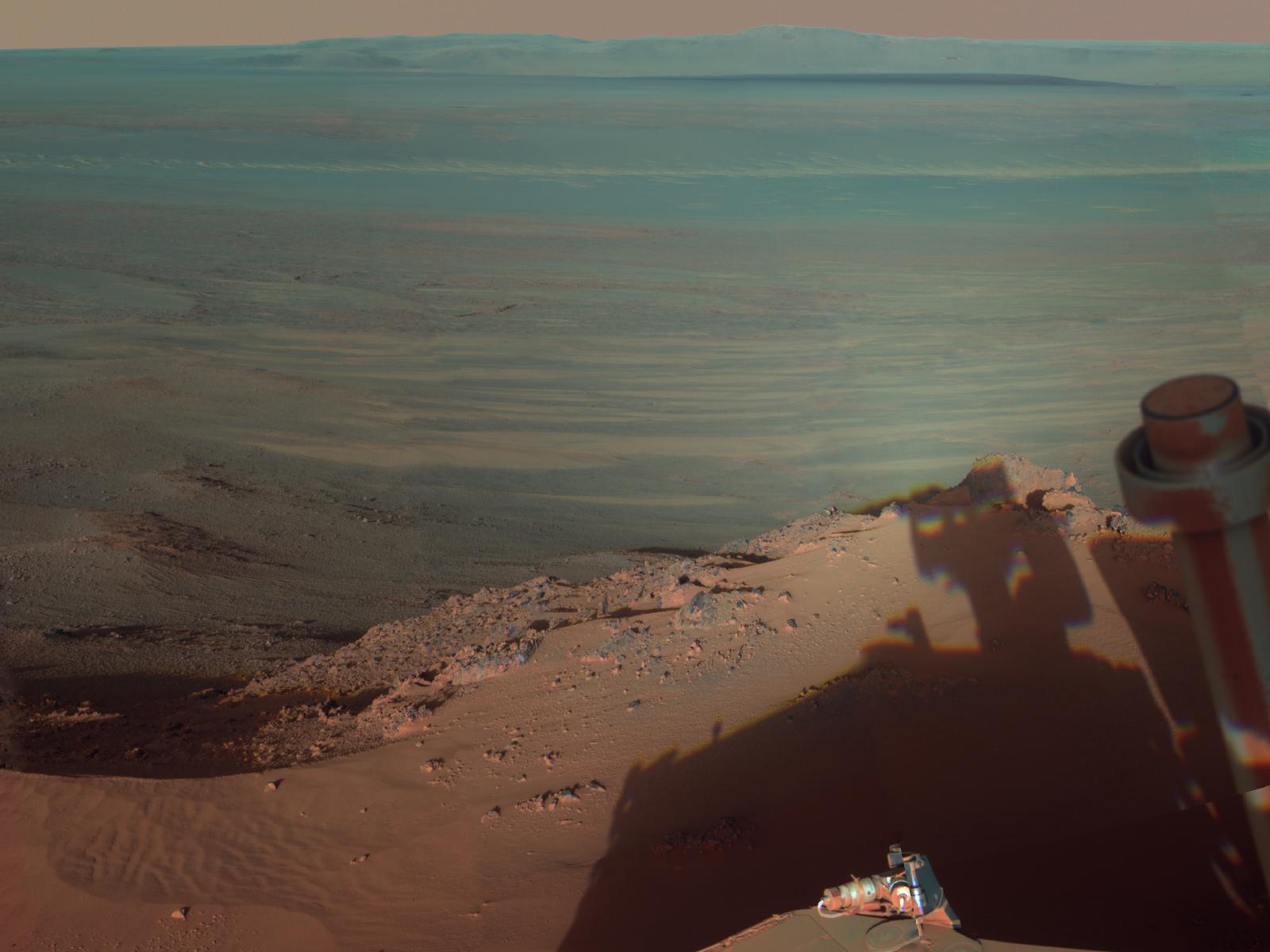Mars Marathon: NASA's Opportunity Rover Near Finish Line of Martian Race

As a car-size rover named Curiosity prepares to land on Mars, another small robotic explorer — NASA's Mars rover Opportunity — is on track to set its own record: The intrepid rover has nearly completed a full marathon on the Red Planet.
The golf cart-size Opportunity, which landed on Mars in 2004, is just 4.2 miles (6.7 km) short of completing the first extraterrestrial marathon, according to NASA officials. A marathon spans 26.2 miles (42.1 km), with athletes at the 2012 Summer Olympics in London set to compete in an Earthly version of the race in just over a week.
As of July, the hardy Opportunity rover has explored nearly 22 miles (35.4 km) of the Martian surface. And it has been quite a journey.
"This particular marathoner had to fly about 283 million miles across space before being unceremoniously drop-bounced on the Martian surface," Ray Arvidson, deputy principal investigator of the Mars Exploration Rover Mission, said in a statement.
Opportunity, like its twin rover Spirit, was designed for a mere three-month mission at Mars, but both rovers far outlasted their warranties. In May 2009, Spirit became trapped in sand, and 10 months later, it fell silent. After numerous failed attempts to revive the rover, NASA declared Spirit dead in May 2011. [Photos From Rovers Spirit & Opportunity]
As part of NASA's initial goal, Opportunity was slated to travel only 1,970 feet (600 meters), making the current distance recorded on the rover's odometer all the more impressive.
Typically, Opportunity drives only 165 to 330 feet (50 to 100 meters) each day. The rover often pauses to investigate its surroundings, taking plenty of photos along the way, NASA officials said. In fact, Opportunity recently beamed back its 100,000th image, a stunning panorama of Mars.
Get the Space.com Newsletter
Breaking space news, the latest updates on rocket launches, skywatching events and more!
Spirit and Opportunity were designed to search for signs of ancient water on the Red Planet. While Mars today is bone-dry and has a thin atmosphere, many researchers believe the planet was a much warmer, wetter place billions of years ago.
Opportunity first detected signs of water in deposits near the rover's landing site in Eagle Crater. As Opportunity drove around, it found more evidence of ancient Mars water. Opportunity then struck out for Endeavor Crater, a giant pit 22.5 miles (36.2 km) across.
Opportunity reached Endeavor Crater in August 2011, and the rover continued to make intriguing discoveries.
"Endeavor is surrounded by fractured sedimentary rock, and the cracks are filled with gypsum," Arvidson said. "Gypsum forms when ground water comes up and fills cracks in the ground, depositing hydrated calcium sulfate. This is the best evidence we've ever found for liquid water on Mars."
Still, Opportunity shows no sign of slowing down. Even after the rover passes the 26.2-mile marker, the team intends to keep going.
"We have no plans to stop running," Arvidson said.
That's good, because while Opportunity has been running a one-rover race, it's about to get some competition.
On Sunday, Aug. 5 PDT, NASA's newest Mars rover is due to touch down on the Red Planet. The Mars rover Curiosity, the centerpiece of NASA's $2.5 billion Mars Science Laboratory mission, is slated to land inside Mars' vast Gale Crater to search for signs that the planet could now or ever in the past host conditions that could support primitive life.
While Opportunity uses solar panels that rely on sunlight to generate power, the Mini Cooper-size Curiosity carries a nuclear power source designed to power its systems for two straight years of uninterrupted exploring. NASA hopes the rover will scale a 3-mile-high mountain at the center of Gale Crater.
Curiosity is scheduled to land on Aug. 5 at 10:31 p.m. PDT (1:31 a.m. EDT, 0531 GMT on Monday, Aug. 6).
Visit SPACE.com for complete coverage of NASA's Mars rover landing Sunday. Follow SPACE.com on Twitter @Spacedotcom. We're also on Facebook and Google+.
Join our Space Forums to keep talking space on the latest missions, night sky and more! And if you have a news tip, correction or comment, let us know at: community@space.com.

Space.com is the premier source of space exploration, innovation and astronomy news, chronicling (and celebrating) humanity's ongoing expansion across the final frontier. Originally founded in 1999, Space.com is, and always has been, the passion of writers and editors who are space fans and also trained journalists. Our current news team consists of Editor-in-Chief Tariq Malik; Editor Hanneke Weitering, Senior Space Writer Mike Wall; Senior Writer Meghan Bartels; Senior Writer Chelsea Gohd, Senior Writer Tereza Pultarova and Staff Writer Alexander Cox, focusing on e-commerce. Senior Producer Steve Spaleta oversees our space videos, with Diana Whitcroft as our Social Media Editor.









